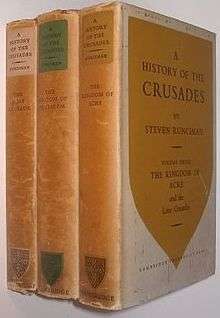A History of the Crusades

(publ. Cambridge University Press)
A History of the Crusades, is a history of the Crusades and is arguably the best known and most widely acclaimed work of historian Steven Runciman.
A 3-volume work published in 1951-4, it has seen numerous reprints and translations. For years it has been the standard by which other Crusade histories have been measured. Encompassing the ascendancy of Islam in the Levant during the early Seventh century through the fall of the Kingdom of Acre in 1291, it offers a foundation for understanding the entire Crusades.
The work draws on a wide range of primary sources (in Greek, Latin, Armenian, Arabic), and at the time of its initial publication it offered a new interpretation of the era, namely, that the Crusades were a barbarian invasion of the East comparable to traditional Germanic invasions that contributed to the fall of Rome. The Crusades, and the foundation of the Crusader states in the Middle East, are seen as destructive, rather than as a noble effort to regain property and land once held by Christian empires. Furthermore, A History of the Crusades incorporated the history of the Byzantine Empire in ways that previous accounts had failed to do. This thesis helped to widen the scope of interest in Crusade history, moving it further east, and at the same time curbed the romantic view of the Crusades still held in some parts of the West.
Runciman's chronological approach to his subject has been seen as a limitation. As Aziz S. Atiya writes, “Runciman’s book is essentially a narrative of crusading events rather than an analytical study and a discussion of problems.”[1] Thomas F. Madden, Professor of History and Director of the Center for Medieval and Renaissance Studies at Saint Louis University once wrote that AHC was “terrible history yet wonderfully entertaining.”[2] This criticism might have been encouraged by Runciman's own attitude, which he described in the first volume of A History of the Crusades as his “one pen against the massed typewriters of the United States”. Runciman believed that, “The historian must attempt to add to his subjective study the qualities of intuitive sympathy and imaginative perception, without which he cannot hope to comprehend the fears and aspirations and convictions that have moved past generations.”[3] This statement is a key to understanding his unique style but also explains much of the criticism leveled at it.
However, the importance of the work has remained undimmed in the minds of many of today’s Crusade historians. Bernard Hamilton wrote, “The first two volumes of Sir Steven’s History of the Crusades were published while I was an undergraduate. I read them with avidity…I still think that his History is one of the great literary works of English historical writing, which has inspired an interest in and enthusiasm for the crusades in a whole generation.”[4] This sentiment may be found in the introductions or the prefaces of many Crusade history books.
References
- ↑ Azis S. Atiya, review of A History of the Crusades, I: The First Crusade and the Foundation of the Kingdom of Jerusalem, by Steven Runciman, Speculum 27 no. 3 (July 1952): 422-425, available from JSTOR, http://www.jstor.org/stable/2853122 (accessed October 17, 2008).
- ↑ Thomas F. Madden, “The Real History of the Crusades”.Crisis Magazine, April 1, 2002, 2. (accessed October 27, 2008).
- ↑ The Great Church in Captivity (1968).
- ↑ Hamilton (2000). The Leper King and his Heirs. Cambridge University Press.